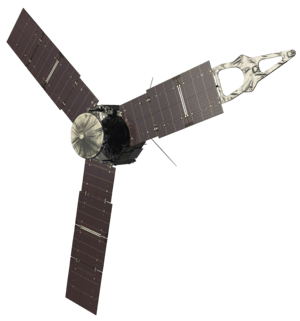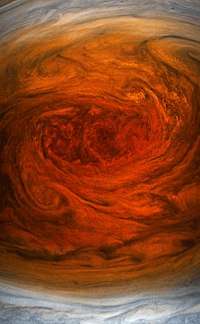JunoCam
JunoCam (or JCM) is the visible-light camera/telescope of the Juno Jupiter orbiter, a NASA space probe launched to the planet Jupiter on 5 August 2011. It was built by Malin Space Science Systems.[1] The telescope/camera has a field of view of 58 degrees with four filters (3 for visible light).[2] The camera is run by the JunoCam Digital Electronics Assembly (JDEA) also made by MSSS.[1] It takes a swath of imaging as the spacecraft rotates; the camera is fixed to the spacecraft so as it rotates, it gets one sweep of observation.[1]
.jpg)


Planned vs. Actual goals
Originally, due to telecommunications constraints, Juno will only be able to return about 40 megabytes of camera data during each 11-day orbital period (this orbital period was later modified). This downlink average data rate of around 325 bits per second will limit the number of images that are captured and transmitted during each orbit to somewhere between 10 and 100 depending on the compression level used.[3] This is comparable to the previous Galileo mission that orbited Jupiter, which captured thousands of images[4] despite its slow data rate of 1000 bits per second (at maximum compression levels) due to antenna problems that crippled its planned 135,000 bit-per-second communications link.
When the spacecraft arrived at the planet it was planned to achieve a 14-day orbit, however this was changed to 53-day orbit.[5]
The primary observation target is planet Jupiter itself, although it is expected if all goes well should be able to capture some limited images of the Jupiter moons Metis and Adrastea.[6]
The JunoCam project is led by Candice Hansen-Koharcheck.[7]JunoCam is not one of the probe's core scientific instruments; it was put on board primarily for public science and outreach, to increase public engagement, and to make all images available on NASA's website.[8][6] It is capable of being used for science, and does have some coordinated activities in regards to this, as well as to engage amateur and as well as professional infrared astronomers.[6]
Design

The JunoCam physical and electronic interfaces are largely based on the MARDI instrument for the Mars Science Laboratory.[1] However, the housing and some aspects of the camera's inner mechanism have been modified to provide stable operation in the planet's comparatively intense radiation and magnetic field.[1] Part of its mission will be to provide close up views of Jupiter's polar region and lower-latitude cloud belts,[1] and at Juno's intended orbit the camera is able to take images at up to 15 kilometres (9.3 mi) per pixel resolution.[1] However, within one hour of closest approach to Jupiter it can take up to 3 kilometres (1.9 mi) pixel, thus exceeding the resolution of Cassini up to that time on Saturn.[1]
The camera is run by the JunoCam Digital Electronics Assembly (JDEA) also made by MSSS.[1] The JunoCam is physically mounted to the body of the spacecraft, and moves with the spacecraft. The Voyager cameras (that also imaged Jupiter) were the only spacecraft cameras that were movable.
In addition to visible light filters, it also has a near infrared filter to help detect clouds; a methane filter in addition the visible color filters.[9] The camera is a "push-broom" type imager, generating an image as the spacecraft turns moving the sensor in sweeping motion over the observation area.[9]
One of the constraints for JunoCam hardware was mass, which limited the size of the optics.[10]
Specifications and mission

The camera and the mission are not designed to study the moons of Jupiter.[11] JunoCam has a field of view that is too wide to resolve any detail in the Jovian moons beyond 232 kilometers per pixel. Jupiter itself will only appear to be 75 pixels across from JunoCam when Juno reaches the furthest point of its orbit around the planet.[3] At its closest approaches JunoCam could achieve 15 km/pixel resolution from 4300 km, while Hubble has taken images of up to 119 km/pixel from 600 million km.[12]
The camera uses a Kodak image sensor, the KODAK KAI-2020, capable of color imaging at 1600 x 1200 pixels: less than 2 megapixels.[13] It has a field of view of 58 degrees with four filters (red, green, blue, and a methane band) to provide color imaging.[9] The low resolution, rigid mounting and lossy compression, applied before transmission makes it effectively the Juno "dashcam".
Juno's planned orbit is highly elongated[11] and takes it close to the poles (within 4,300 kilometres (2,700 mi)), but then far beyond Callisto's orbit, the most distant Galilean moon.[11] This orbital design helps the spacecraft (and its complement of scientific instruments) avoid Jupiter's radiation belts, which have a record of damaging spacecraft electronics and solar panels.[11] The 'Juno Radiation Vault', with titanium walls, will also aid in protecting and shielding Juno's electronics.[14] Despite the intense magnetosphere of Jupiter, the JunoCam was expected to be operational for at least the first eight orbits (September 2017),[15] but as of April 2020 (26 orbits) remains active and has also been re-purposed from an outreach-only camera to a scientific instrument to study the dynamics of Jupiter's clouds and polar storms.[16][17]
Images
- Earth
 A color view of Earth assembled from 82 images as the spacecraft spun, at an altitude of 1,987 miles (3,197 kilometers), 10 minutes before closest approach
A color view of Earth assembled from 82 images as the spacecraft spun, at an altitude of 1,987 miles (3,197 kilometers), 10 minutes before closest approach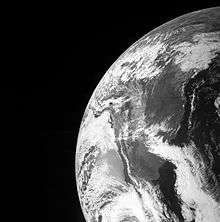 JunoCam views Earth (centered on South America) in October 2013 during the spacecraft's flyby en route to Jupiter
JunoCam views Earth (centered on South America) in October 2013 during the spacecraft's flyby en route to Jupiter
- Jupiter system
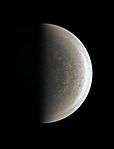 Jupiter's polar region captured by JunoCam.
Jupiter's polar region captured by JunoCam.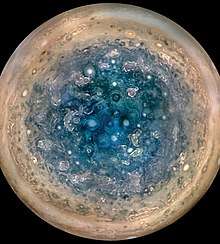 Jupiter – southern storms – viewed by JunoCam.[18]
Jupiter – southern storms – viewed by JunoCam.[18] Jupiter's Moon Io, as recorded by JunoCam
Jupiter's Moon Io, as recorded by JunoCam Jupiter's polar region in 1974 during Pioneer 11's gravity assist to Saturn. (Historical background for Jupiter imaging)
Jupiter's polar region in 1974 during Pioneer 11's gravity assist to Saturn. (Historical background for Jupiter imaging)
Additional camera proposal
In 2005 the Italian Space Agency (ASI) proposed an additional visible light instrument "ItaCam", but instead they built a near-infrared camera/spectrometer, "Jovian Infrared Auroral Mapper" (JIRAM) and a Ka-band transponder.[11] ASI previously contributed a near-infrared instrument to the Cassini–Huygens Saturn probe.[11] The Ka-band instrument, KaTS, is a component of the Gravity Science experiment
See also
- Galileo (spacecraft), NASA space probe to Jupiter 1989–2003.
- Citizen science
Other cameras manufactured by Malin Space Science Systems:
- Mars Color Imager for the Mars Reconnaissance Orbiter (MRO) spacecraft
- Context (CTX) Camera also for the MRO spacecraft
- Mars Orbiter Camera
Other Juno instruments:
- Jovian Auroral Distributions Experiment (JADE)
- Jovian Infrared Auroral Mapper (JIRAM)
- JEDI
- Magnetometer (Juno) (MAG)
References
- "Malin Space Science Systems - Junocam, Juno Jupiter Orbiter". Retrieved 2016-07-17.
- Patrick Irwin (2009). Giant Planets of Our Solar System: Atmospheres, Composition, and Structure. Springer Science & Business Media. p. 352. ISBN 978-3-540-85158-5.
- Junocam will get us great global shots down onto Jupiter's poles (The Planetary Society)
- Galileo Legacy Site Image Gallery (NASA)
- "NASA's Juno Prepares to Jump Jupiter's Shadow". NASA/JPL. Retrieved 2019-12-09.
- Hansen, C. J.; Orton, G. S. (2015-12-01). "JunoCam: Science and Outreach Opportunities with Juno". AGU Fall Meeting Abstracts. 41: P41B–2066. Bibcode:2015AGUFM.P41B2066H.
- "PSI's Hansen-Koharcheck Honored By NASA For JunoCam Project Leadership". www.spaceref.com. Retrieved 2019-02-09.
- Wall, Mike (12 July 2016). "Juno Spacecraft Captures 1st Photo from Jupiter Orbit". space.com. Retrieved 16 December 2018.
- JunoCam: Juno's Outreach Camera (PDF)
- Science, Meghan Bartels 2018-12-27T13:09:28Z; Astronomy. "JunoCam Images Are Where Science Meets Art and NASA Meets the Public". Space.com. Retrieved 2019-12-09.
- Bruce Moomaw, "Juno Gets A Little Bigger With One More Payload For Jovian Delivery", 2007
- Collision leaves giant Jupiter bruised - NASA, ESA, Michael Wong (Space Telescope Science Institute, Baltimore, MD), H. B. Hammel (Space Science Institute, Boulder, CO) and the Jupiter Impact Team (accessed September 25, 2010)
- Photexels - JunoCam Uses Kodak Image Sensor To Capture Jupiter (August 5, 2011)
- Setting up Juno's Radiation Vault (NASA)
- "Understanding Juno's Orbit: An Interview with NASA's Scott Bolton". Universe Today. 2016-01-08. Retrieved 6 February 2016.
- Greicius, Tony (April 16, 2020). "Churning Texture in Jupiter's Atmopshere". Juno Image Gallery. National Aeronautics and Space Administration. Retrieved April 17, 2020.
- "NASA's Juno Mission Halfway to Jupiter Science".
- Chang, Kenneth (May 25, 2017). "NASA's Jupiter Mission Reveals the 'Brand-New and Unexpected'". New York Times. Retrieved May 27, 2017.
External links
| Wikimedia Commons has media related to JunoCam. |
